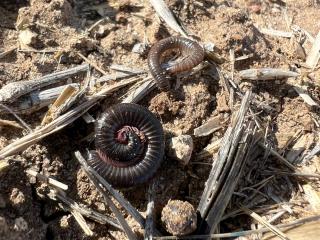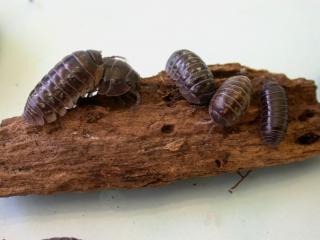Slaters and Portuguese millipedes are damaging crop seedlings
- Grass Patch

Quenten Knight (Agronomy Focus) has reported finding damage in emerging oats from slaters and Portuguese millipedes north-east of Grass Patch. Quenten noted that the damage was confined to heavy cloddy soil with delayed crop emergence.
Slaters and Portuguese millipedes feed on organic matter in the soil and can occasionally attack living plants by chewing the leaves and stems. Slaters can cause extensive damage to emerging seedlings, and while crop damage by Portuguese millipedes is unusual, the incidence has increased in recent seasons. Large numbers of Portuguese millipedes can be present in paddocks and not cause crop damage.
Slaters
- Kulin
- Cascades
- Munglinup
Dani Whyte (Braeleigh Consulting) has reported extensive damage from slaters in an oat seedling crop near Kulin, where up to 10 ha of the crop has been severely damaged. The oat crop had been sown into dense stubble.
Monica Field (Farm and General) has also reported slater damage to emerging canola crops near Cascades and Munglinup.
Introduced slaters have only recently become a problem in high rainfall crops sown into dense stubble. Damage to canola crops may be more noticeable in later sown crops that have experienced moisture stress and in paddocks with heavier loams and clays. Slaters survive on organic matter on the soil surface and a heavy stubble load may aid their survival over summer. If the organic matter dries out the slaters cannot survive.
Slaters have a hard skeleton on the outside of their bodies, 7 pairs of jointed legs, and 2 pairs of antennae.
The common slater, Porcellio scaber, grows up to 20 mm in length and is usually pale grey. The pill bug, Armadillidium vulgare, which can roll into a ball when disturbed, grows up to 18 mm and is dark brown to black in colour. Both are European species that are now widespread in Australia.
Portuguese millipedes
Growers in the southern region may have noticed an increase in Portuguese millipede (Ommatoiulus moreleti) populations in recent seasons, particularly after the first rainfall of the season.
Portuguese millipedes are native to southwest Europe, and after being accidentally introduced into Western Australia (WA) in 1986 are now commonly found in the southwest region. These millipedes are easily transported between properties and to new regions through infested soil, plant material and in farm machinery.
Increases in Portuguese millipede numbers have been linked to an increased uptake of no-till practices, stubble retention, and improvements in soil organic matter which can provide a favourable habitat for millipede populations. Cesar Australia have reported some damage to emerging canola crops in South Australia, New South Wales and Victoria in recent years, and suggest that millipedes feed on crop plants to access moisture when it is limited. More information is available on Cesar Australia’s Black Portuguese millipede PestNote.
The smooth, cylindrical body of the Portuguese millipede distinguishes it from native millipede species, which look bumpier. Native millipedes are usually found in low numbers and are widespread. Portuguese millipedes congregate in large numbers around houses and sheds on farms and are quite mobile, especially after the first rains in autumn.
Black Portuguese millipedes will curl up into a tight spiral when disturbed, or try to escape with thrashing, snake-like movements. Adults are 20 to 45 mm long when fully developed and range in colour from slate-grey to black. The juveniles are light grey/brown, often with a darker stripe along each side. For more information on the millipede’s life cycle see DPIRD’s Portuguese millipedes page.
How to check crops and manage slaters and Portuguese millipedes
Crops can be checked by observing plant damage and searching at night. Portuguese millipedes are attracted to light and slaters are easily found under stubble in the vicinity of crop damage.
Slaters cause uneven rasping-type damage that can appear similar to slug and snail damage. They can chew the tops of emerging cotyledons or leaves of crop seedlings, leaving only the seedling stumps.
Portuguese millipede damage to canola crops can appear as irregular pieces chewed from the leaves, or dead seedlings if chewing damage is severe. Damage to cereals can also occur if the stems of young plants are chewed.
Control options are limited but there are some measures that will curb populations including cultural control methods to remove or decrease the amount of stubble on the ground in early autumn. Early sowing of high-vigour varieties at a higher seeding rate will help compensate for seedling losses from pest damage.
At crop germination the only management option for slaters and millipedes is to bait or to spray. The application of residual insecticide sprays have had some efficacy in protecting a germinating canola crop from damage. However, as both of these pests are nocturnal and shelter under stubble it can be difficult to get good spray coverage for their control.
Slaters and millipedes will seek out baits when actively feeding.
Insecticide products with the active ingredients fipronil and metaldehyde are currently the only bait formulation registered for canola in WA for agricultural areas.
Further information
For more information on slaters refer to:
- DPIRD’s Diagnosing slaters in crops page
- Grains Research and Development Corporation (GRDC) Mitigating snails, slugs and slaters in Southern Western Australia.
For more information on Portuguese millipedes refer to:
- DPIRD’s Portuguese millipedes page
- Cesar Australia’s Black Portuguese millipede PestNote
- GRDC’s Millipedes and slaters in no-till systems fact sheet.
For more information contact Research Scientist Svetlana Micic in Albany on +61 (0)8 9892 8591.
Article author: Bec Severtson (DPIRD Northam).


